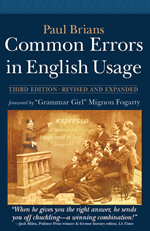The second person has perfectly legitimate uses, even when you are not directly addressing another specific person as I am doing in this sentence (I am addressing you, the reader). One example is the giving of directions: “to reach the Pegasus Coffee House, you drive west on Winslow Way to Madison, turn left to the end of Madison, then turn right onto Parfitt Way, and you’ll see Pegasus on your left.”
It is also commonly used in an indefinite way, where a more formal writer might use “one”: “You can eat all you want at Tiny’s salad bar.”
It can be disorienting to switch from first person to second: “I always order pizza with extra cheese because you know that otherwise they’re not going to give you enough.” But sometimes such a switch works well to broaden the context of a sentence. For example: “I hate living in the dorm because other people always want to party when you’re trying to study.” The first part of the sentence is specifically about feelings of the speaker, but the second part is about a general pattern which affects many other people who can plausibly be referred to as “you.”
Because the use of the second person conveys an intimate, casual tone, many teachers discourage its use in class essays, feeling that it gives an unsophisticated air to student prose. Be careful about using it in such essays unless you know that your teacher approves.
BUY THE BOOK!
